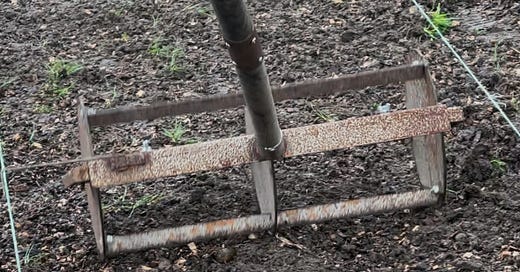How we plant thousands of plants with a tent peg and market gardening tools
Plant small, learn from market gardeners and mulch like your life depends on it.
Last year, we planted around 7,000 seedlings—all without mechanical equipment—just blood, sweat, tears (literally), and a few incredible tools from American market gardeners, along with my most used tool: a tent peg.
We’re often asked how we plant up a bed, so I thought it might be useful to break down the process step by step.
If I could offer just one piece of advice when it comes to planting, it would be this: plant small! The time savings are enormous. We typically plant plugs around 3cm in size, and each one takes me roughly 30 seconds to plant. For 7,000 plants, that adds up to 58 hours and 20 minutes.
In contrast, planting larger plants (like 9cm pots, which are commonly used) would take a staggering 136 hours and 7 minutes. That’s a difference of 77 hours and 47 minutes—just think of all the extra things we could do with that time! Maybe binge-watch a few shows (just kidding... kind of). Or, if we were paying someone else at £25 per hour, that would cost us £1,944.58!
The time savings from planting small really do add up.
When planting small, there are a few challenges to watch out for, such as pest attacks (slugs and snails, I’m looking at you!) and weather issues like flooding and frosts. But the time we save by planting smaller plugs allows us to grow a few extra plants to compensate for any losses.
For those of you who have visited our farm or followed us on socials, you’ve probably heard me mention Never Sink Farm Tools. I’m clinically obsessed with everything they do and sell. The time their tools have saved us on labour is absolutely invaluable.
Never Sink Farm is an organic vegetable market garden in America, one of the highest-producing farms per square foot in the country. They practice hand farming, using manual tools to replicate the work of a tractor. Their designs for manual tools for market gardeners are thankfully available in the UK through Reag Tools.
Prior to planting up a bed, we use the Master Gridder tool from Never Sink to space out our plantings, setting the exact number of inches we want between each plant. It creates a grid in the soil, making sure everything is aligned perfectly. While it may sound simple, getting the spacing just right and ensuring everything is in a straight line is trickier than it seems. The gridder helps us do this quickly and accurately.
Why does this matter so much? Well, during the busy season, we really don’t want to spend hours on our hands and knees hand weeding. Instead, we use hoes, which allow us to move faster and more efficiently. Having everything in straight lines means we can walk up and down the beds, hoeing between the rows without damaging the plants. It saves time and helps protect our backs and knees!
Russell usually takes care of the gridding part. Due to my dyspraxia, I’m not the best at walking in straight lines, especially backwards—so that task is all his. Once he’s finished using the Gridder, he moves through the bed, creating holes for the plants with a drill auger. A drill auger is a tool that attaches to a power drill, with a spiral design that helps it quickly bore into the soil. I know a drill is technically a piece of mechanical equipment, but let’s be honest—it’s nothing compared to the tractors that dig the holes for you!
Farming is hard on the body. We both find digging thousands of holes by hand to be physically taxing, so the drill auger helps reduce that strain. It’s also great for fluffing the soil up a little before planting. Ours was an inexpensive buy from Amazon that fits our Lidl’s finest battery powered drill!
Once the holes are drilled, I handle all the planting while Russell starts gridding up a new bed. Armed with my trusty tent peg (the marigolds are optional), I pick up each plug, dip it in a seaweed feed (which promotes healthy growth), and pop it into the hole, which is usually the perfect size!
Once a bed is fully planted, we do our best to mulch right away. We follow Jeff Lowenfels theory for mulching—using brown material for perennials (fungi-dominated) and green material for annuals (bacteria-dominated). For us, woodchips serve as the brown mulch, and grass clippings are our green mulch. Both materials we can get for free and we have an abundance of grass clippings!
We didn’t manage to mulch every bed last season, and this year we really regret leaving any beds uncovered. It’s an awful job having to weed over 60 beds during the winter!
So my top tips - plant small, learn from market gardeners and mulch like your life depends on it.




Fascinating and so good to read your process for thousands of plants. Do you have to cover a lot of plants to protect from birds?